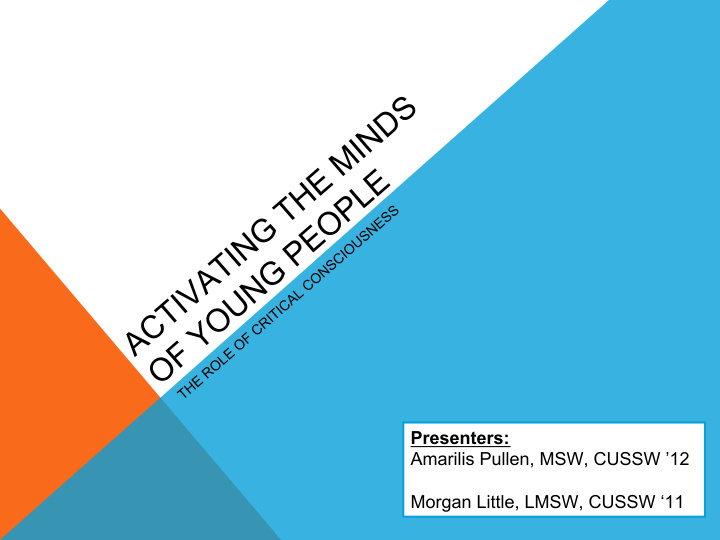



Presenters: Amarilis Pullen, MSW, CUSSW ’12 Morgan Little, LMSW, CUSSW ‘11
Welcome & Icebreaker
WHY GROUP AGREEMENTS? • Share the purpose upfront • Difference between “braver or safer” spaces vs. “safe” spaces • Centering youth voice • Accountability in the group for all, address adultism head on • Maintain awareness of our own identities as they relate to systems of oppression • Real talk • Be nimble • Keep it posted
PERRIN FAMILY FOUNDATION: YOUTH IN ACTION
SNLP FRAMEWORK OUR PHILOSOPHY, WHICH IS OUR GUIDING FORCE, IS BUILT ON THE FOLLOWING BELIEFS: • That the foundation of leadership lies in service and activism • That positive reform will result from challenging accepted notions of leadership • That young women can be a catalyst for social change.
LEARNING SESSION GOALS • Discuss and analyze the framework of critical consciousness. • Apply learning and gain resources to operationalize concepts with hands-on tools, techniques and activities. • Any other goals we should add as a collective?
THE BIRTH OF CRITICAL CONSCIOUSNESS “Banking education treats students as objects of assistance, problem posing education makes them critical thinkers.” ~Paulo Freire
OVERVIEW OF CRITICAL CONSCIOUS IN YOUTH DEVELOPMENT Critical Action Critical Analysis Critical Reflection Critical Consciousness Critical Consciousness is the ability to recognize and analyze systems of inequality and develop a critical lens to navigate and challenge these systems.
DISJOINTED OR INTERCONNECTED EC0-SYSTEM? Schools (Including school-based programs) Youth Youth Development Organizing Spaces supporting youth Direct Religious Service Institutions Programs Government Sanctioned Leadership Boards Are we fully examining the inter-connectivity between micro (individual), mezzo (community), and macro (political) levels of analysis in our social work practice, regardless of environment?
WHAT DOES IT TAKE? Do Your Homework and Treat Youth Experience as Knowledge Be an Adult Ally Commit to the Long-term Process Give Up Power-Youth Voice/ Youth-led
STEPS OF CRITICAL REFLECTION Community Learning Emo0onal Engagement Cogni0ve Awakening Inten0on to Act The adaptable critical reflection component of critical consciousness is necessary and most often left out of youth development practice s.
ACTIVITY: Let’s Talk Identity <
DEBRIEF: CIRCLE, SQUARE, TRIANGLE: Circle: What is still circling in your head after the activity? Square : Anything that squares with your thinking or beliefs-identify? Triangle : What are three important points that you are taking away from the dialogue?
RESOURCES Research: • Critical Consciousness: Current Status and Future Directions by Roderick J. Watts, Matthew A. Diemer, Adam M. Voight • From Assets to Agents of Change: Social Justice, Organizing and Youth Development by Shawn Ginwright, Taj James Trainings: • Morningside Center for Teaching Social Responsibility • Race Forward • S.O.U.L Training • Liberation Based Healing Conference • Border Crossers
Resources Continued Tools/Books ● Brotherhood/Sister SOL Curriculum ● Identity Mapping ● Human Barometer Activity ● Flower of Power ● A Girl Like Me ● Emergent Strategy by Adrienne Maree Brown ● Teaching Tolerance
Thank you! Any questions or lingering thoughts? Artist: Brandan Odums, Studio B New Orleans
STAY CONNECTED! Amarilis Pullen, Program Officer Morgan Little, Director of Perrin Family Foundation Programs apullen@perrinfamilyfoundation.or Sadie Nash Leadership Project g Morgan@sadienash.org www.perrinfamilyfoundation.org www.sadienash.org “The learning process is something you can incite, literally incite, like a riot.”~Audre Lorde
Recommend
More recommend